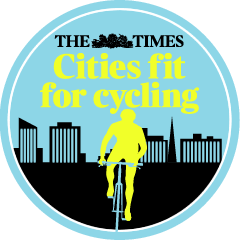
Newswatch: The Times Cities Fit for Cycling Campaign

London: A Friday morning almost three months ago a news reporter at The Times, Mary Bower, was hit by a lorry. Luckily she survived – but is still not conscious. This accident has moved The Times to launch an impressive safety campaign: “Cities Fit for Cycling”.
Despite the tragic circumstances it is inspiring to finally experience a cycling safety campaign that doesn’t ignore the bull but steers straight towards it:
There are the authorities who have neglected to ensure that junctions like those on The Highway in Wapping — or countless others where cyclists have been maimed and killed in Britain — are made safe for cars, lorries and cyclists to co-exist safely.
Mary, a news reporter, would be the first to ask why it is not mandatory for lorries driving on city streets to be fitted with sensors and mirrors to pick up cyclists in their blind spots. Or why training for cyclists and drivers on how to share the road responsibly is so poor. Or why some junctions are so dangerous that jumping a red light can actually be a safer option than lining up alongside HGVs at the lights like a racetrack starting grid. Or why London trails so far behind cities such as Amsterdam and Copenhagen in terms of the infrastructure and legislation to protect vulnerable cyclists and to help the drivers who are trying to avoid them.
Such questions deserve both attention and answers! Therefore, The Times has launched a public campaign and an 8-point manifesto calling for cities to be made fit for cycling:
1. Trucks entering a city centre should be required by law to fit sensors, audible truck-turning alarms, extra mirrors and safety bars to stop cyclists being thrown under the wheels.
2. The 500 most dangerous road junctions must be identified, redesigned or fitted with priority traffic lights for cyclists and Trixi mirrors that allow lorry drivers to see cyclists on their near-side.
3. A national audit of cycling to find out how many people cycle in Britain and how cyclists are killed or injured should be held to underpin effective cycle safety.
4. Two per cent of the Highways Agency budget should be earmarked for next generation cycle routes, providing £100 million a year towards world-class cycling infrastructure. Each year cities should be graded on the quality of cycling provision.
5. The training of cyclists and drivers must improve and cycle safety should become a core part of the driving test.
6. 20mph should become the default speed limit in residential areas where there are no cycle lanes.
7. Businesses should be invited to sponsor cycleways and cycling super-highways, mirroring the Barclays-backed bicycle hire scheme in London.
8. Every city, even those without an elected mayor, should appoint a cycling commissioner to push home reforms.
ECF highly supports The Times initiative and recommends everyone to take action and support the Cities Fit for Cycling Campaign!
Founded in 1983, the European Cyclists’ Federation (ECF) is the umbrella federation of the national cyclists’ associations in Europe, reinforced by similar organisations from other parts of the world. ECF seeks to change attitudes, policies and budget allocations at the European level. ECF stimulates and organises the exchange of information and expertise on bicycle related transport policies and strategies as well as the work of the cyclists’ movement.
Contact the author
Recent news!
Upcoming events
Contact Us
Avenue des Arts, 7-8
Postal address: Rue de la Charité, 22
1210 Brussels, Belgium











